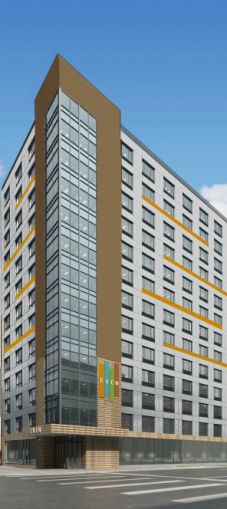Brooklyn Hotel Pipeline Expands
By Lauren Elkies Schram February 27, 2014 7:45 am
reprints

There are 22 hotel projects with 2,208 rooms in the pipeline in Brooklyn as of January, according to data provided by lodging industry benchmarking services firm STR to Commercial Observer. That represents a spike in room count year-over-year from 1,370, and an uptick in the number of hotels from 14.
Of the 22 current projects, four (with 212 rooms) are in the planning stages, six (with 609 rooms) are in the final planning stages and 12 (with 1,387 rooms) are in construction.
Pipeline projects include two InterContinental Hotels Group hotels in Downtown Brooklyn, a Toll Brothers and Starwood (STWD) Capital project in Dumbo and a Zelig Weiss hotel in Williamsburg.
Construction began at the end of last year on InterContinental’s hotel at the intersection of Nevins and Schermerhorn Streets in Downtown Brooklyn. The 13-story hotel with 204 rooms will be under the EVEN Hotels brand. The architect on the project is Gene Kaufman.
InterContinental also has partnered with 300 Schermerhorn Realty LLC for a new $80 million 246-room Holiday Inn called Holiday Inn Brooklyn Nevins Station, at 300 Schermerhorn Street in Downtown Brooklyn. Construction is expected to be completed by the end of this year, with an anticipated opening in early 2015. Mr. Kaufman is also the architect for this project.
Also, Toll Brothers and Starwood’s Brooklyn Bridge Park Hotel & Residences is currently under construction at Pier 1 in Dumbo.
And, there is a 320,000-square-foot mixed-use commercial development under construction in Williamsburg which will include a 183-room hotel. The project, by Mr. Weiss, is at 55 Wythe Avenue between North 12th and North 13th Streets. Demolition is slated to commence early next month with the retail portion scheduled to be delivered by year end, according to Geoffrey T. Bailey of SCG Retail, who is marketing the retail portion of the project.
Meanwhile, the hotel market wasn’t strong in Brooklyn last month, other statistics indicate.
In January, the Brooklyn hotel occupancy rate dropped 10.6 percent year-over-year, to 66.3 percent, according to other data from STR. The average daily room rate also dipped 8.7 percent to $141.42. Demand (meaning the number of rooms sold) declined 10.6 percent to 81,961 and supply (defined as the number of rooms times the number of days in the period) remained flat at 123,566 rooms.
Jan Freitag, a senior vice president at STR, said not to take the occupancy rate dip too seriously. In January 2014, Brooklyn hotel room demand was 81,691, down from January 2013’s 91,691. But the 2013 figure was inflated because of the scramble for rooms in the wake of Hurricane Sandy, Mr. Freitag said.
“What you see is that the number of rooms sold in the borough in 2011 was roughly 48,000,” he said. “In January 2012, it was roughly 63,000. I would not put too much stake in the January 2014 decline because in reality 2013 in January was a one-time outlier.”
And then there was the winter storm effect. Sean Hennessey, the founder and chief executive officer of Lodging Advisors, which provides counseling services to key players in the hotel industry, said that January was impacted by the severe winter storms, with big events being rescheduled and trips deferred until after this month’s Super Bowl.
In addition, he said: “This upheaval on the demand side, together with a 6 percent increase in citywide hotel inventory and growing availability from services like Airbnb, resulted in a difficult month. Brooklyn hotels generally fill after those in Manhattan, so a citywide slowdown hits Brooklyn especially hard.”


